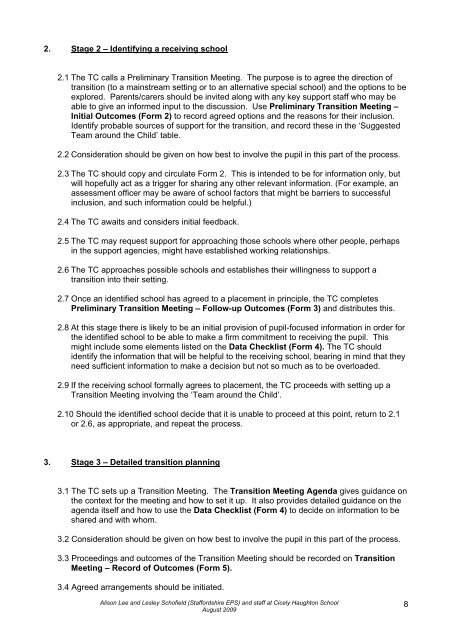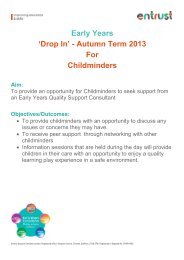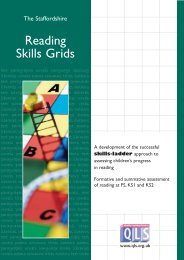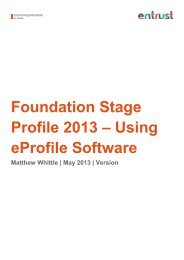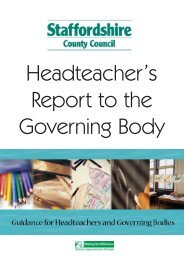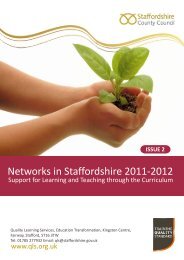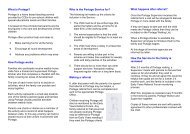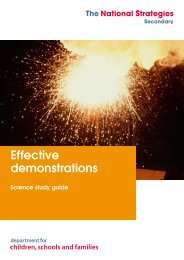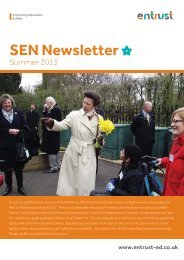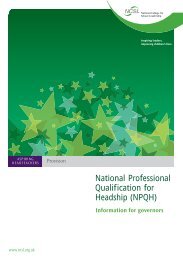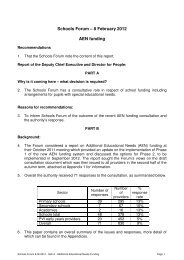Moving On: A Framework for Transitions - Staffordshire Learning Net ...
Moving On: A Framework for Transitions - Staffordshire Learning Net ...
Moving On: A Framework for Transitions - Staffordshire Learning Net ...
Create successful ePaper yourself
Turn your PDF publications into a flip-book with our unique Google optimized e-Paper software.
2. Stage 2 – Identifying a receiving school<br />
2.1 The TC calls a Preliminary Transition Meeting. The purpose is to agree the direction of<br />
transition (to a mainstream setting or to an alternative special school) and the options to be<br />
explored. Parents/carers should be invited along with any key support staff who may be<br />
able to give an in<strong>for</strong>med input to the discussion. Use Preliminary Transition Meeting –<br />
Initial Outcomes (Form 2) to record agreed options and the reasons <strong>for</strong> their inclusion.<br />
Identify probable sources of support <strong>for</strong> the transition, and record these in the ‘Suggested<br />
Team around the Child’ table.<br />
2.2 Consideration should be given on how best to involve the pupil in this part of the process.<br />
2.3 The TC should copy and circulate Form 2. This is intended to be <strong>for</strong> in<strong>for</strong>mation only, but<br />
will hopefully act as a trigger <strong>for</strong> sharing any other relevant in<strong>for</strong>mation. (For example, an<br />
assessment officer may be aware of school factors that might be barriers to successful<br />
inclusion, and such in<strong>for</strong>mation could be helpful.)<br />
2.4 The TC awaits and considers initial feedback.<br />
2.5 The TC may request support <strong>for</strong> approaching those schools where other people, perhaps<br />
in the support agencies, might have established working relationships.<br />
2.6 The TC approaches possible schools and establishes their willingness to support a<br />
transition into their setting.<br />
2.7 <strong>On</strong>ce an identified school has agreed to a placement in principle, the TC completes<br />
Preliminary Transition Meeting – Follow-up Outcomes (Form 3) and distributes this.<br />
2.8 At this stage there is likely to be an initial provision of pupil-focused in<strong>for</strong>mation in order <strong>for</strong><br />
the identified school to be able to make a firm commitment to receiving the pupil. This<br />
might include some elements listed on the Data Checklist (Form 4). The TC should<br />
identify the in<strong>for</strong>mation that will be helpful to the receiving school, bearing in mind that they<br />
need sufficient in<strong>for</strong>mation to make a decision but not so much as to be overloaded.<br />
2.9 If the receiving school <strong>for</strong>mally agrees to placement, the TC proceeds with setting up a<br />
Transition Meeting involving the ‘Team around the Child’.<br />
2.10 Should the identified school decide that it is unable to proceed at this point, return to 2.1<br />
or 2.6, as appropriate, and repeat the process.<br />
3. Stage 3 – Detailed transition planning<br />
3.1 The TC sets up a Transition Meeting. The Transition Meeting Agenda gives guidance on<br />
the context <strong>for</strong> the meeting and how to set it up. It also provides detailed guidance on the<br />
agenda itself and how to use the Data Checklist (Form 4) to decide on in<strong>for</strong>mation to be<br />
shared and with whom.<br />
3.2 Consideration should be given on how best to involve the pupil in this part of the process.<br />
3.3 Proceedings and outcomes of the Transition Meeting should be recorded on Transition<br />
Meeting – Record of Outcomes (Form 5).<br />
3.4 Agreed arrangements should be initiated.<br />
Alison Lee and Lesley Schofield (Staf<strong>for</strong>dshire EPS) and staff at Cicely Haughton School<br />
August 2009<br />
8


